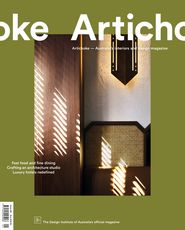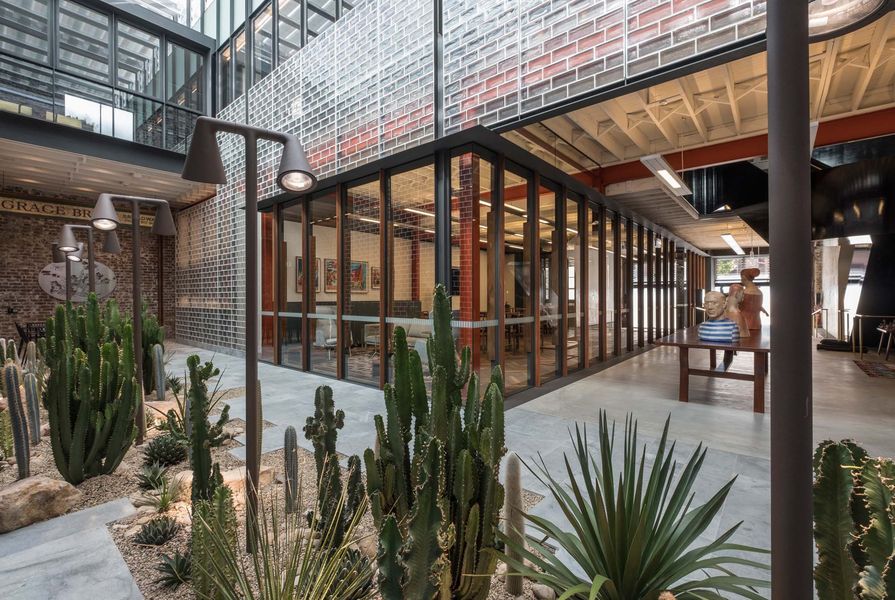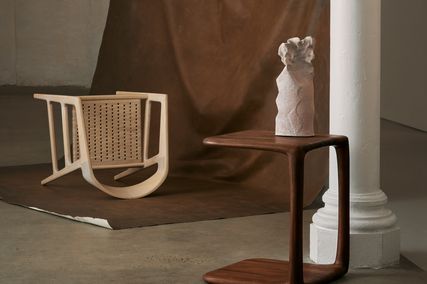Wandering the streets of Chippendale, it would be very easy to pass by the facade of Tonkin Zulaikha Greer’s (TZG) latest interior project without giving the building a second glance. A handsome early-twentieth-century brick factory, like so many found within the old industrial neighbourhoods of Sydney, its perfunctory street presence doesn’t give much away of what lies behind the steel and glass portal.
75 Myrtle Street is no ordinary warehouse conversion. It is in fact, quite exceptional. It was not conceived as a speculative development project, nor for a tech or design start up. The client, Judith Neilson, art collector, philanthropist, business woman and architectural patron, chose to expand her investment in the rejuvenation of Chippendale by commissioning TZG to create an administrative headquarters for her diverse suite of activities.
Glass walls provide acoustic privacy and a visual connection between spaces. Artwork: A Cleansed World (2013) by Li Zhan
Image: David Roche
TZG is known for its extensive and highly acclaimed work of adaptive reuse, particularly in Sydney. The practice is very familiar with the language of Sydney’s industrial architecture, so this project shouldn’t have posed too many challenges. However, the client – not one to shy away from bold architectural commissions – threw down the design gauntlet by proposing that the space combine the gritty heritage of the former glass factory and the elegance of a contemporary home. Tim Greer, director at TZG, says that “industrial and elegance are not two words that normally go together” and that this apparent aesthetic paradox formed the basis of their design response.
The existing building was an accretion of various layers and additions. Greer sees these as “orders” that define the scheme and its expression. The first is the timber structure of the building that fronts the street. This typifies Sydney industrial architecture – brick facade, big timber columns and beams. All of these elements were retained and restored. The second order – “the steel order” – are later additions to the factory. These have been painted an ochre red to clearly mark out their presence. The “new order” works between these two pre-existing layers, cutting, layering and slotting wherever possible. Lastly is the “termite order.” The structural reports found severe termite damage to many of the timber columns. A datum was struck and the damaged sections were removed and replaced with new steel bases. The “termite order” was also used to provide design variation to the meeting room timber uprights and the bottom of some of the fins have stopped short, as if having been gnawed off.
The client wanted the meeting spaces to feel like “rooms in a home” and this has been achieved through a careful selection of furnishings and artworks.
Image: David Roche
Greer says that the client wanted the meeting spaces to feel like “rooms in a home.” In contrast to the polished concrete floors of the circulation areas, the meeting rooms have parquetry made from recycled timber. The thresholds are marked out in a dark zinc while the window reveals have been detailed in a muted grey that is repeated in the credenzas. The predominance of timber and the selection of furnishings and artworks makes them feel like no other meeting space I can recall. Acoustic privacy is provided by the glass while the visual connection between spaces means that natural light and spaciousness is guaranteed. Services are hidden among mirrored recesses that give the illusion of the ceiling space flowing throughout the whole of the space. This project is full of engaging details.
The succulent garden forms a double-height atrium between the rear office zone and the front office zone. Hand-cast glass blocks from Japan line the walls and provide an opalescent silver shimmer. Greer says that a double inference is drawn from the Maison de Verre in Paris and the site’s original use as a glass factory.
Image: David Roche
A black steel-plate staircase leads to the upstairs office areas. Throughout the space, polished brass is used to contrast with the dark timbers and black metals. No where is this more dramatically used than in the staircase. The gloss black paint and the polished brass bring the “elegance” factor, right down to the brass tactile ground surface indicators. The upper level is comprised of a series of split-level offices to the left and large single-level offices to the right. The architects worked with the existing floor levels so as to maintain the giant timber truss on the upper level. This truss runs across the floor with the entry to the offices fitted to work between the diagonal braces.
Greer says that Tonkin Zulaikha Greer always try to “define the relationship to make the architecture.” In 75 Myrtle Street, the relationships between the building, client, designers and brief have resulted in exceptional interior architecture. The project successfully tells of the site’s industrial past while still delivering an elegant take on contemporary workplace design.
Source

Project
Published online: 27 May 2019
Words:
Sing d'Arcy
Images:
David Roche
Issue
Artichoke, March 2019
























